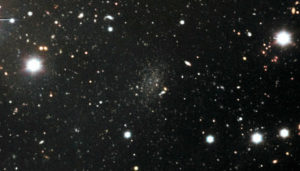Donatiello I is a tiny galaxy about 10 million light-years away, and it was discovered by an Italian hobbyist with a homemade telescope.

Galileo National Telescope / Gran Telescopio Canarias / G. Donatiello
In an era of giant telescopes scouring the sky from both the ground and in space, one could be forgiven for thinking there wasn’t much left for an enthusiastic hobbyist to discover. But with patience and the right equipment, even an amateur astronomer can stumble on to an undiscovered galaxy.
From the dark skies of Pollino National Park in southern Italy, Giuseppe Donatiello had been investigating the Andromeda Galaxy with his home-built telescope, looking for previously reported dwarf galaxies and stellar streams. In images acquired late in 2010 and 2013, Donatiello noticed an unidentified smudge of light. That smudge turned out to be a dwarf spheroidal galaxy — now dubbed Donatiello I — lurking on the far side of Andromeda.
“I literally jumped for joy,” says Donatiello. “I have always had a great interest in the Local Group and for dwarf galaxies in general, so finding one of these systems is truly an immense joy.”
Donatiello I is a runt, as far as galaxies go. Assuming a distance of around 10 million light-years, it appears to be roughly several thousand light-years across. Our own galaxy, by comparison, spans about 100,000 light-years. The dwarf galaxy is faint, too. With a surface brightness of just 26.5 magnitudes per square arcsecond, it’s barely visible against the sky.
To make his discovery, Donatiello relied on an extra-low dispersion 127-mm f/9 refractor, assembled from parts from different telescopes, and an off-the-shelf cooled 2-megapixel CCD camera. “Modern amateur astronomers have amazing equipment for doing significant contributions to new topics in astronomy, like galaxy formation [and] dwarf galaxy censuses,” says David Martínez-Delgado (Heidelberg University, Germany), lead author on the paper reporting the discovery, published October 10th on the astronomy preprint arXiv.
Martínez-Delgado came across the discovery on Facebook. Donatiello had posted his discovery image to the site, after convincing himself that the galaxy was the real deal when he noticed a similar smudge at the same coordinates (RA 01h 11m 40.37s, dec. +34° 36' 3.2") in images from the Sloan Digital Sky Survey. Martínez-Delgado reached out and offered to collaborate on a paper, partly to ensure that Donatiello got the discovery credit that he deserved.
The pros took a closer look with the 3.58-meter Galileo National Telescope and the 10.4-meter Gran Telescopio Canarias, both on the Canary Island of La Palma. Martínez-Delgado and colleagues tried to measure the distance to Donatiello I by identifying the brightest red giant stars in the dense center of the galaxy and comparing their apparent magnitudes to their intrinsic luminosities. Atmospheric conditions weren’t ideal for this kind of work, providing estimates only, but the dwarf galaxy appears to be old and on its own, just outside our Local Group of galaxies.
“If Donatiello I is actually an isolated old galaxy, its stellar population can provide important clues about its star formation history and about the process that could stop the star formation,” says Martínez-Delgado. “There is no interaction with massive host galaxies here, so it is not as easy to explain how the galaxy lost its gas a long time ago.”
Martínez-Delgado and colleagues hope to get a better look at this galaxy with the Hubble Space Telescope. That should allow them to nail down the distance, which in turn would provide more precise estimates of other properties such as size and mass.
Donatiello, meanwhile, plans to keep searching. “I have always had a great interest in dwarf galaxies, so I will continue in this direction,” he says. “But more generally, I am interested in galactic archeology, so at the same time I will dedicate myself to the search for stellar streams around Milky-Way-like galaxies.”
Check out more of Donatiello's images on his flickr page.
Reference:
D. Martínez-Delgado et al. “Mirach's Goblin: Discovery of a Dwarf Spheroidal Galaxy Behind the Andromeda Galaxy.” arXiv.org. October 10, 2018.
 0
0









Comments
You must be logged in to post a comment.